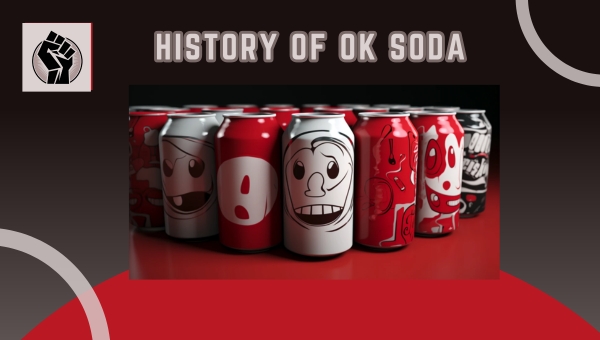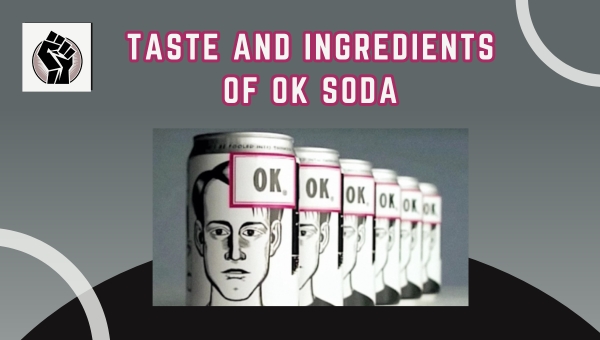A soda that didn’t promise happiness or excitement but embraced being “just OK.” OK Soda, launched in the 1990s, was more than a drink; it was a marketing experiment aimed at disillusioned youth. With quirky packaging and ironic advertising, it stood out boldly in a crowded market.
However, its journey was short-lived, leaving behind a legacy of curiosity and lessons. What made OK Soda so unique, and why did it vanish so quickly? Let’s explore its story, from its unconventional launch to its cultural impact, and unravel the reasons behind its rise and fall.
History of OK Soda
OK Soda was introduced in the early 1990s by The Coca-Cola Company as a bold experiment to capture the attention of a younger audience. It was an attempt to break away from traditional soda marketing, focusing on a unique identity that resonated with Generation X. Let’s dive deeper into its launch, marketing strategy, and eventual decline.

The Launch of OK Soda
The launch of OK Soda in 1993 was an ambitious step by Coca-Cola. This product was introduced in select test markets across the United States, aiming to appeal to a youth demographic that was seen as skeptical of large corporations and conventional advertising.
The branding was deliberately unpolished and straightforward, with the word “OK” symbolizing neutrality rather than excitement. Its entry into the market was accompanied by an emphasis on being different, with a focus on irony and self-awareness. Coca-Cola hoped this unconventional approach would set OK Soda apart in an already saturated market.
Marketing and Target Audience
OK Soda’s marketing strategy was anything but ordinary. Coca-Cola targeted Generation X, a group known for its cynicism and distrust of conventional advertising. The campaign leaned heavily on irony, rejecting the overly cheerful tone used by other soda brands. The design featured stark, comic-style artwork, and the messaging avoided any promise of happiness or excitement.
The product was backed by a unique manifesto printed on the cans, promoting transparency and authenticity. This approach was a direct appeal to young consumers who felt disconnected from traditional marketing.
Additionally, advertisements embraced an offbeat, self-deprecating tone, reflecting a “we know you don’t trust us” attitude. Despite its intention to connect with this audience, the soda’s message often confused consumers, leaving the target demographic divided.
The Decline and Discontinuation
OK Soda saw a rapid decline after its initial introduction. Several factors contributed to its downfall:
- Limited Market Appeal: The ironic and self-aware tone of OK Soda’s marketing failed to resonate with a broad audience, leaving many feeling indifferent.
- Underwhelming Sales: Despite the hype, the product sold only about 1 million cases, far below expectations.
- Taste Perception: The unusual flavor profile didn’t appeal to enough consumers, further limiting its success.
- Market Competition: In a crowded beverage market dominated by established brands, OK Soda struggled to carve out a lasting niche.
By 1995, Coca-Cola discontinued the product, recognizing its inability to achieve significant traction or profitability.
Also Read: Stary Soda – Discover the Refreshing Sensation
Taste and Ingredients Of Ok Soda
OK Soda was more than just a beverage; it attempted to create a distinctive sensory experience. Its taste and composition were designed to stand out, offering something unique to consumers. Let’s explore its flavor and how it compared to other sodas.

Flavor Profile
The flavor of OK Soda was unconventional and aimed to differentiate itself from the typical fizzy drink. Here’s what stood out:
- Citrus Undertones: A refreshing hint of citrus gave the drink a zesty twist.
- Spicy Notes: Subtle spices added depth, creating a layered flavor profile.
- Less Sweetness: Unlike traditional colas, it leaned toward a less sugary taste.
- Mixed Reception: While some found the taste intriguing, others described it as overly experimental, with comparisons to odd flavors like “carbonated tree sap.”
Comparison to Other Sodas
When stacked against more established sodas, OK Soda’s taste and ingredients took a different approach.
Below are some key comparisons:
- Sugar Levels: OK Soda was less sugary compared to classics like Coca-Cola or Pepsi, catering to those who preferred a lighter sweetness.
- Flavor Complexity: Its blend of citrus and spice contrasted with the predominantly sweet and straightforward flavors of other sodas.
- Marketing Connection: While other sodas focused on delivering universally appealing flavors, OK Soda’s unique taste mirrored its bold and niche branding strategy.
OK Soda’s taste reflected its attempt to redefine what a soda could be, making it a distinctive entry in the beverage industry.
Cultural Impact of OK Soda
The brief journey of OK Soda in the world of beverages has left a lasting impression, especially for those who remember its distinct approach. The soda’s cultural impact lies in its unconventional marketing and the loyal fanbase it cultivated, despite its short-lived presence.

Advertising Campaign and Design
OK Soda’s advertising campaign and design were anything but ordinary. It stood out as a bold experiment that pushed boundaries in the beverage industry.
Here’s what made it unique:
- Distinct Aesthetic: The product packaging featured dark, comic-style illustrations that were visually striking and appealed to a countercultural audience.
- Self-Aware Messaging: The advertisements often poked fun at traditional marketing, offering a raw and direct tone that resonated with skeptical youth.
- OK Manifesto: Each can display a manifesto, blending humor and philosophy, emphasizing individuality, and embracing mediocrity.
- Interactive Campaigns: Creative tactics like chain letters and hotline numbers were used, inviting consumers to engage with the brand in an unconventional way.
These elements showcased an approach that was far ahead of its time, emphasizing a connection with its audience rather than a standard sales pitch.
Cult Following and Legacy
Although OK Soda was short-lived, it managed to gather a dedicated cult following, which remains a testament to its unique identity.
Here’s how it gained this status:
- Symbol of 90s Counterculture: For many, soda became an emblem of rebellion against mainstream consumerism during the 1990s.
- Nostalgia Factor: Fans continue to reminisce about its quirky branding and the cultural vibe it represented, keeping its memory alive.
- Impact on Modern Marketing: Soda’s ironic and self-aware strategies influenced how brands approach authenticity and relatability today.
- Pop Culture Reference: OK Soda is often cited in discussions about bold marketing experiments and remains a topic of interest in retrospectives on failed yet memorable products.
The soda’s legacy lives on as a fascinating example of how a product can transcend its commercial failure to become a cultural icon.
Criticisms and Controversies
OK Soda, despite its bold approach and unique branding, was not free from criticism and controversies. It sparked varied reactions from both consumers and media, which played a significant role in its short-lived journey. Let’s explore how it was received and the discussions it generated.
Reception by Consumers
The consumer reception of OK Soda was a mix of admiration and disapproval. While some found the concept refreshing, others struggled to connect with its identity.
Here are a few key takeaways:
- Mixed Taste Reviews: Some appreciated the distinctive, less sweet flavor, while others described it as odd or unappealing.
- Branding Confusion: Many consumers found the ironic marketing intriguing, but others felt it lacked clarity and direction.
- Limited Appeal: The unique approach resonated with a niche audience but left a majority indifferent or uninterested.
- Loyal Enthusiasts: A small segment of fans admired the soda’s unconventional nature and embraced its offbeat identity.
Media Reactions
OK Soda’s launch and eventual discontinuation drew notable attention from media outlets. The reactions varied, shedding light on both its innovative aspects and its shortcomings.
- Initial Curiosity: The soda’s bold marketing campaign generated significant buzz during its launch phase.
- Critiques on Taste: Many reviews highlighted that the flavor was just “okay,” aligning with the soda’s name but detracting from its appeal.
- Marketing Strategy Analysis: Media often debated the effectiveness of the irony-driven branding, with some labeling it as ahead of its time and others calling it overly complex.
- Legacy Discussions: In retrospective analyses, media outlets have recognized OK Soda as a fascinating case study in unconventional marketing and branding.
These diverse reactions from consumers and the media illustrate the challenges OK Soda faced in carving out a sustainable presence in the competitive beverage market.
Also Read: Zeema Drink | The Refreshing Story
Pros and Cons of OK Drink
Below, we explore the pros and cons of consuming Ok Soda to help you make an informed decision.
Pros:
- Unique Branding: OK Drink stood out with its unconventional marketing approach, making it distinctive in the soda market.
- Cultural Relevance: It resonated with a niche audience, particularly Generation X, by addressing their skepticism of traditional advertising.
- Flavor Innovation: The citrusy and slightly spicy flavor profile offered something different from the typical colas of its time.
- Memorable Design: The bold and artistic designs left a lasting impression, appealing to alternative youth culture.
- Cult Status: Despite its short run, it developed a loyal following, keeping its legacy alive even today.
Cons:
- Limited Appeal: The ironic tone and branding failed to connect with a broader audience, limiting its market reach.
- Disappointing Sales: The product sold fewer cases than expected, leading to its discontinuation.
- Flavor Polarization: The taste was divisive, with many finding it unusual or unappealing.
- Market Saturation: It struggled to compete in an already crowded soda market.
- Short Shelf Life: The drink was discontinued quickly, leaving little room to adjust its strategy or grow.
FAQs
Why was OK Soda discontinued?
OK Soda was discontinued due to its limited market appeal and underwhelming sales. Despite innovative marketing, it failed to connect with a broad audience, leading Coca-Cola to withdraw it from shelves by 1995.
What did OK Soda taste like?
OK Soda had a unique flavor described as a mix of citrus with a hint of spiciness. While some found it refreshing, others compared it to “carbonated tree sap,” reflecting its polarizing taste.
Is it good to eat soda?
Soda is typically not recommended as part of a healthy diet due to its high sugar content and artificial additives. Consuming it occasionally in moderation is generally considered acceptable.
Conclusion
OK Soda remains a fascinating case in the history of beverages, showcasing both innovation and missteps in marketing and product design. Despite its short lifespan, it left a lasting impression as a bold experiment in connecting with a specific demographic.
Its unique flavor, unconventional branding, and cultural impact continue to spark discussions even today. While it ultimately failed to gain widespread appeal, OK Soda serves as a lesson in understanding consumer preferences and the risks of veering too far from traditional strategies.
If you found this exploration intriguing, don’t forget to explore more captivating stories and insights on our blog. Dive into more engaging reads today!





